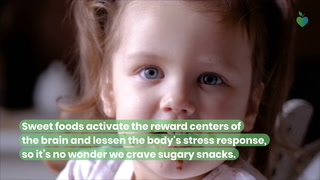The 6 Best and 5 Worst Candies for Your Health
6 Candies That Are Better Options for Your Health

Next up video playing in 10 seconds
But when special occasions such as Valentine's Day, Easter, or Halloween roll around, the temptations for sweet foods become nearly unavoidable. Amy Gorin, RDN, the owner of Plant Based With Amy in Stamford, Connecticut, admits that given this reality, indulging can be difficult to resist.
So go ahead and embrace the sweet season. Here are the healthiest (and least healthy) candies, per Gorin and Mia Syn, RDN, the owner of Nutrition by Mia in Charleston, South Carolina, and the author of Mostly Plant-Based.

The 6 Healthiest Candy Options
1. UnReal Milk Chocolate Gems
“I’m really impressed with these,” says Gorin. “The candy contains no artificial flavor or color, and the coloring comes from natural sources, like turmeric.”
Because these contain a fair amount of sugar, though, you’ll want to stick with the 1.3-ounce (oz) grab-and-go bags, which make the perfect single serving, says Kelly Kennedy, RDN, Everyday Health’s staff nutritionist.
What’s Inside 170 calories per package, 10g fat, 6g saturated fat, 22g carbohydrate, 18g sugar, 4g protein
UnReal Milk Chocolate Gems nutrition info
2. Endangered Species Chocolate Extreme Dark 88 Percent Cocoa Dark Chocolate
What’s Inside 180 calories per oz, 13g fat, 8g saturated fat, 11g carbohydrate, 3g sugar, 3g protein
Chocolate Extreme Dark 88 Percent Cocoa Dark Chocolate nutrition info
3. Peanut M&M’s
What’s Inside 90 calories per "fun-size" pack, 4.5g fat, 2g saturated fat, 11g carbohydrate, 9g sugar, 2g protein
M&M's Peanut Fun-Size Chocolate Candies nutrition info
4. Snickers
Surprised? Although Snickers is relatively higher in calories than other candy, Gorin recommends a "fun-size" bar because it’s more likely to leave you satisfied, thanks to containing some protein. “It also has less sugar than some other candies that are almost entirely pure sugar,” she says.
What’s Inside 80 calories per "fun-size" bar, 4g fat, 1.5g saturated fat, 10g carbohydrate, 9g sugar, 1g protein
Snickers Fun-Size Chocolate Candy Bar nutrition info
5. Reese’s Peanut Butter Cups
The satisfying combo of protein and a small amount of fiber makes this another good pick, says Gorin. Plus, around the holidays, it’s easy to find single cups (usually they come in a pack of two), so it's easier to satisfy your sweet tooth in moderation.
What’s Inside 110 calories per cup, 6g fat, 2g saturated fat, 12g carbohydrate, 11g sugar, 2g protein
Reese's Peanut Butter Cups nutrition info
6. Blow Pop
For the nonchocolate lovers, a Blow Pop can be a practical pick. “It has less sugar than many of the other candies out there, and because of the gum center, you can enjoy it for longer,” says Gorin.
What’s Inside 70 calories per pop, 0g fat, 0g saturated fat, 17g carbohydrate, 13g sugar, 0g protein
.png?sfvrsn=b7529eb8_3)
The 5 Least Healthy Candy Options
1. Candy Corn
It has a reputation as being one of the most hated candies, and a 2024 CandyStore.com survey on the best and worst Halloween candy found this festive confection is indeed the third-most hated — after Circus Peanuts and Peanut Butter Kisses. But whatever your opinion of it, candy corn certainly isn’t the most nutritious way to satisfy your sweet tooth. “It contains more than double the sugar of a Snickers or Reese’s,” says Gorin.
What’s Inside 110 calories for 15 pieces, 0g fat, 0g saturated fat, 23g sugar
Brach's Classic Candy Corn nutrition info
2. Smarties
Yes, they’re lower in calories than many other candies, but those are purely empty calories — “they have little nutritional value,” says Syn. “They give your body energy from carbohydrates (sugar) but lack the other essential nutrients like protein, vitamins, and minerals.”
What’s Inside 15 calories for 1 roll, 0g fat, 0g saturated fat, 4g carbohydrates, 4g sugar, 0g protein
Smarties Candy Rolls nutrition info
3. Gummy Bears
Again, gummy bears are pure sugar, so they’re unlikely to keep you as satisfied as chocolate, says Gorin.
What’s Inside 100 calories for 13 pieces, 0g fat, 0g saturated fat, 23g carbohydrates, 14g sugar, 2g protein
Haribo Goldbears Gummi Candi nutrition info
4. Jelly Beans
The package may get you because it says it’s fat free, but unless you absolutely love jelly beans — and can keep your portion reasonable — they’re still just sugar, says Gorin.
What’s Inside 110 calories for 27 pieces, 0g fat, 0g saturated fat, 28g carbohydrates, 21g sugar, 0g protein
Jelly Belly Assorted Flavor Beans nutrition info
5. Airheads
Packed with artificial colors and flavors and pure sugar, these may take you back to when you were a kid, but they won’t satisfy, Kennedy says.
What’s Inside 60 calories per bar, 0g fat, 0g saturated fat, 15g carbohydrates, 11g sugar, 0g protein
Airheads nutrition info
How to Include Candy in Your Healthy Diet
If you’re struggling to enjoy candy in moderation, these tips may help.
Store it strategically. Put candy out of sight, like in the back of your pantry, or in the freezer, says Gorin. When it’s not staring you in the face, “you’re not constantly tempted by it,” she says.
Plan for when you’ll indulge. Eat candy as a planned part of dessert rather than when you’re running around or doing other things — like working or driving — so that you truly enjoy it. Of course, you can and should enjoy festive candy, but there comes a point where it loses its luster and you may be eating it out of habit, so get rid of it after a week, Gorin advises.
Choose your preferred treat. Yes, even regardless of the best and worst choices below! If you truly enjoy what you’re eating, you’ll be satisfied by it. “Even if your favorite isn't the most nutritious, finding a way to fit it into an overall healthy diet pattern and taking the time to enjoy every bite is a great way to make sure you don't feel deprived,” Kennedy says. That means don’t let “fat-free” labels or calorie counts sway you from what you truly know you want. Syn puts it simply: The best candy choice is the one you can eat and enjoy in moderation.
The Takeaway
- Candy is generally unhealthy, but there are times of the year — like Christmas and Halloween — when candy (and other sweets) are part of traditions and celebrations.
- Experts say that planning for these periods of unhealthy indulgence can help you stick to healthier eating habits.
- Healthier candy options generally contain less artificial flavors and colors, and nuts are usually a positive addition to candy, thanks to their high fiber and healthy fat content.
- The unhealthy options tend to include artificial colors and flavors and pack high amounts of sugar into each serving.
- Sugar 101. American Heart Association. September 23, 2024.
- Healthy Eating Plan. National Heart, Blood, and Lung Institute.
- Søberg S et al. FGF21 Is a Sugar-Induced Hormone Associated With Sweet Intake and Preference in Humans. Cell Metabolism. May 2, 2017.
- Ducrot P et al. Meal Planning Is Associated With Food Variety, Diet Quality and Body Weight Status in Large Sample of French Adults. International Journal of Behavioral Nutrition and Physical Activity. February 2, 2017.
- Rana A et al. Health benefits of polyphenols: A concise review. Journal of Food Biochemistry. October 2022.
- Saturated Fat. American Heart Association. August 23, 2024.
- Lou X et al. Timing and Nutrient Type of Isocaloric Snacks Impacted Postprandial Glycemic and Insulinemic Responses of the Subsequent Meal in Healthy Subjects. Nutrients. February 14, 2024.
- Fiber: The Carb That Helps You Manage Diabetes. Centers for Disease Control and Prevention. October 8, 2024.

Reyna Franco, RDN
Medical Reviewer
Reyna Franco, RDN, is a New York City–based dietitian-nutritionist, certified specialist in sports dietetics, and certified personal trainer. She is a diplomate of the American College of Lifestyle Medicine and has a master's degree in nutrition and exercise physiology from Columbia University.
In her private practice, she provides medical nutrition therapy for weight management, sports nutrition, diabetes, cardiac disease, renal disease, gastrointestinal disorders, cancer, food allergies, eating disorders, and childhood nutrition. To serve her diverse patients, she demonstrates cultural sensitivity and knowledge of customary food practices. She applies the tenets of lifestyle medicine to reduce the risk of chronic disease and improve health outcomes for her patients.
Franco is also a corporate wellness consultant who conducts wellness counseling and seminars for organizations of every size. She taught sports nutrition to medical students at the Albert Einstein College of Medicine, taught life cycle nutrition and nutrition counseling to undergraduate students at LaGuardia Community College, and precepts nutrition students and interns. She created the sports nutrition rotation for the New York Distance Dietetic Internship program.
She is the chair of the American College of Lifestyle Medicine's Registered Dietitian-Nutritionist Member Interest Group. She is also the treasurer and secretary of the New York State Academy of Nutrition and Dietetics, having previously served in many other leadership roles for the organization, including as past president, awards committee chair, and grant committee chair, among others. She is active in the local Greater New York Dietetic Association and Long Island Academy of Nutrition and Dietetics, too.

Jessica Migala
Author
Jessica Migala is a freelance writer with over 15 years of experience, specializing in health, nutrition, fitness, and beauty. She has written extensively about vision care, diabetes, dermatology, gastrointestinal health, cardiovascular health, cancer, pregnancy, and gynecology. She was previously an assistant editor at Prevention where she wrote monthly science-based beauty news items and feature stories.
She has contributed to more than 40 print and digital publications, including Cosmopolitan, O:The Oprah Magazine, Real Simple, Woman’s Day, Women’s Health, Fitness, Family Circle, Health, Prevention, Self, VICE, and more. Migala lives in the Chicago suburbs with her husband, two young boys, rescue beagle, and 15 fish. When not reporting, she likes running, bike rides, and a glass of wine (in moderation, of course).

